Fig. 3.—
Sequence relationship of recombinant sorghum CR5 and Setaria CR1 elements to their respective parents. The CR elements are drawn to scale, and vertical bars mark the ends of the 5′-LTR, 5′-UTR, polypurine tract preceeding the 3′-LTR and the 3′-LTR. (a) Four recombinant subgroups of sorghum CR5-Sb-[R1-R4] (i.e., R1–R4) are derived from sorghum CR5-Sb/CR6-Sb and rice CR5-Osj-A subfamilies. CR5-Osj-A was transferred to the sorghum genome via HT, where it recombined with CR5-Sb element to form CR5-Sb-R1 recombinants 1–4. CR5-Sb itself is thought to be a recombinant of CR6-Sb-A and a CR5-Sb progenitor that could not be detected. The oldest CR5-Sb-[R1-R4] member inserted 0.900 ± 0.116 Ma, and older members of parent CR5-Osj-A subfamily appear to have been lost from the sequenced Oryza sativa ssp. japonica genome. Only two young members of CR5-Osj-A family less than 0.026 ± 0.018 Ma could be detected in the current rice genome assembly. (b) Three recombinant subgroups of Setaria italica CR1-Si (R1, R1del, and R2) are derived from Se. italica CR1-Si-A and an O. minuta CR1-Om-like element (CR1-Si-B) that was transferred to the Se. italica genome via HT.

